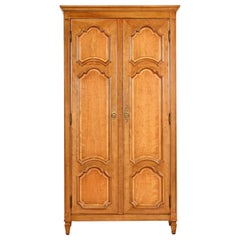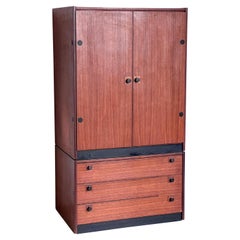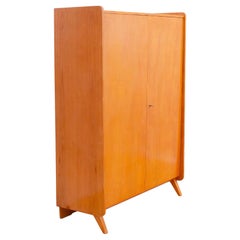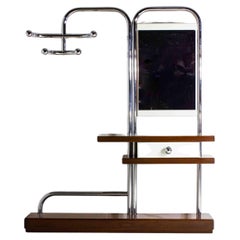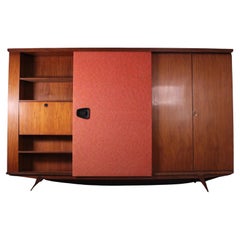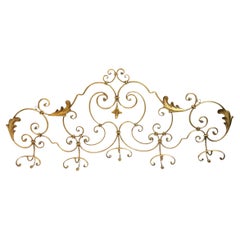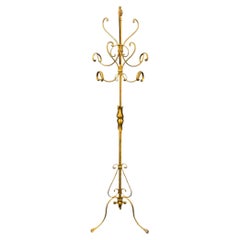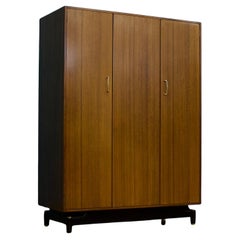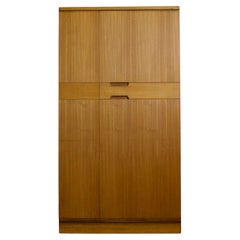1960s Bedroom Armoire
Vintage 1960s American Louis XVI Wardrobes and Armoires
Brass
Vintage 1970s Italian Mid-Century Modern Wardrobes and Armoires
Wood, Walnut
Mid-20th Century Czech Mid-Century Modern Wardrobes and Armoires
Wood, Beech, Plywood
Vintage 1960s Italian Space Age Wardrobes and Armoires
Chrome
Vintage 1960s Modern Wardrobes and Armoires
Wood
Vintage 1960s Italian Mid-Century Modern Wardrobes and Armoires
Metal
Vintage 1960s German Mid-Century Modern Wardrobes and Armoires
Metal
Mid-20th Century British Mid-Century Modern Wardrobes and Armoires
Teak
Mid-20th Century British Mid-Century Modern Wardrobes and Armoires
Teak, Walnut
Mid-20th Century British Mid-Century Modern Wardrobes and Armoires
Teak, Walnut
Vintage 1960s Mid-Century Modern Wardrobes and Armoires
Wood
Mid-20th Century French Mid-Century Modern Wardrobes and Armoires
Ceramic, Oak
Vintage 1960s Austrian Mid-Century Modern Wardrobes and Armoires
Brass
Vintage 1960s Austrian Mid-Century Modern Wardrobes and Armoires
Brass
Vintage 1960s Wardrobes and Armoires
Wood
Mid-20th Century Danish Mid-Century Modern Wardrobes and Armoires
Teak
Vintage 1960s German Mid-Century Modern Wardrobes and Armoires
Metal
Vintage 1960s Scandinavian Mid-Century Modern Wardrobes and Armoires
Iron
Mid-20th Century British Mid-Century Modern Wardrobes and Armoires
Oak
Mid-20th Century British Mid-Century Modern Wardrobes and Armoires
Teak, Walnut
Mid-20th Century British Mid-Century Modern Wardrobes and Armoires
Teak, Walnut
Mid-20th Century Mid-Century Modern Wardrobes and Armoires
Wood
Mid-20th Century British Mid-Century Modern Wardrobes and Armoires
Oak
Mid-20th Century British Mid-Century Modern Wardrobes and Armoires
Teak
Mid-20th Century Italian Mid-Century Modern Wardrobes and Armoires
Wood
Mid-20th Century British Mid-Century Modern Wardrobes and Armoires
Teak
Mid-20th Century British Mid-Century Modern Wardrobes and Armoires
Teak
Mid-20th Century British Mid-Century Modern Wardrobes and Armoires
Teak
Vintage 1960s Italian Mid-Century Modern Wardrobes and Armoires
Metal
Mid-20th Century European Mid-Century Modern Wardrobes and Armoires
Teak
Mid-20th Century British Mid-Century Modern Wardrobes and Armoires
Teak
Vintage 1970s Danish Wardrobes and Armoires
Teak
Mid-20th Century Chinese Wardrobes and Armoires
Bronze
Mid-20th Century British Mid-Century Modern Wardrobes and Armoires
Walnut
Mid-20th Century Italian Mid-Century Modern Wardrobes and Armoires
Wicker, Rattan, Wood
Vintage 1960s Belgian Mid-Century Modern Wardrobes and Armoires
Wood
Mid-20th Century European Mid-Century Modern Wardrobes and Armoires
Teak
Mid-20th Century British Mid-Century Modern Wardrobes and Armoires
Teak
Mid-20th Century British Mid-Century Modern Wardrobes and Armoires
Teak
Vintage 1960s German Mid-Century Modern Wardrobes and Armoires
Walnut
Vintage 1960s Italian Post-Modern Wardrobes and Armoires
Chrome
Vintage 1960s Wardrobes and Armoires
Brass
Vintage 1960s British Mid-Century Modern Wardrobes and Armoires
Rosewood, Teak
Vintage 1950s Austrian Mid-Century Modern Wardrobes and Armoires
Brass
Vintage 1960s Belgian Mid-Century Modern Wardrobes and Armoires
Laminate, Cherry
Vintage 1960s Italian Mid-Century Modern Wardrobes and Armoires
Brass
Vintage 1960s French Wardrobes and Armoires
Metal
Vintage 1960s German Mid-Century Modern Wardrobes and Armoires
Teak
Vintage 1960s British Mid-Century Modern Wardrobes and Armoires
Walnut
Mid-20th Century German Mid-Century Modern Wardrobes and Armoires
Metal
Vintage 1960s Danish Mid-Century Modern Wardrobes and Armoires
Brass
Vintage 1960s European Mid-Century Modern Wardrobes and Armoires
Metal
Vintage 1960s Italian Wardrobes and Armoires
Earthenware, Glass
Vintage 1960s Italian Wardrobes and Armoires
Brass
Vintage 1960s Italian Wardrobes and Armoires
Marble, Brass
Vintage 1960s Italian Wardrobes and Armoires
Brass
Vintage 1960s English Wardrobes and Armoires
Acrylic, Lacquer, Wood
Vintage 1960s Italian Wardrobes and Armoires
Brass
Vintage 1960s Italian Wardrobes and Armoires
Brass
Vintage 1970s Mid-Century Modern Dressers
Rosewood
- 1
1960s Bedroom Armoire For Sale on 1stDibs
How Much is a 1960s Bedroom Armoire?
Finding the Right Wardrobes-armoires for You
When shopping for antique and vintage wardrobes and armoires for your home, there are several things to keep in mind, not least of which is question number 1:
What is the difference between an armoire and a wardrobe?
The difference between an armoire and a wardrobe is actually simple: An armoire is merely an ornate wardrobe. A wardrobe is a tall, streamlined storage cabinet that usually has some combination of drawers, shelves and hanging rods.
Antique and vintage armoires, on the other hand, are freestanding, heavy wooden structures that typically feature decorative metal hinges and pictorial carvings. Armoires are large cabinets that aren’t outfitted with the varied storage features that wardrobes now commonly have. Armoires often have one or two doors and a hanging bar and allow for quick access. Whether a minimalist mid-century modern wardrobe or grandiose Victorian-era armoire is the right fit for you, both are highly functional furnishings and can be a smart storage solution.
Armoires have been around since medieval times, and initially they may have housed weapons and armor. In their early days, armoires were often adorned with elaborate carvings and lavish paintings, particularly in Renaissance-era France. During the 18th century and later, armoires were widely known as “presses” for hanging clothes, and they were so large that they swallowed up the room where they stood.
In today’s modern homes, an antique armoire can be a striking, architectural work of art amid comparably unadorned furnishings. Whether you’re using your piece in the kitchen for cookware or as a food pantry, in the bedroom for clothes or in the living room as a media console, it will likely become a lovable focal point.
The evolution of the armoire can be seen in today’s corner wardrobes, which may rest on an asymmetrical base to account for corner placement, and even mirrored wardrobes, which feature a mirror affixed to the inside panel of one of the doors for convenience. Contemporary wardrobes commonly feature additional sliding trays and drawers and hanging space for clothing or linens, and the cabinet doors make them ideal for concealing televisions and computer monitors when such devices aren’t in use.
When choosing the right wardrobe or vintage armoire for your home, it’s good to have the following in mind: What are you planning to store in it? How much of what you’re storing will need to be housed in it? It should be big enough to accommodate your needs. What is the size of the room where your wardrobe or armoire will live? A large new piece of furniture in a modest space can easily become a hindrance if you have to navigate your way around it during your daily routine, so be mindful of the area you'll need in order to move freely.
Whether you are looking for an antique walnut armoire or a simple contemporary wardrobe, find the right piece for your home today on 1stDibs.
- Were there watches in the 1960s?1 Answer1stDibs ExpertFebruary 13, 2023Yes, there were watches in the 1960s. The first recorded wristwatch dates back to 1868, when Patek Philippe, a watchmaker founded in Geneva in 1839 by Polish expats Antoni Patek and Franciszek Czapek, designed a timepiece for Countess Koscowicz of Hungary. Shop a collection of vintage watches from some of the world’s top sellers on 1stDibs.
- What is a caftan from the 1960s?1 Answer1stDibs ExpertFebruary 13, 2023A caftan from the 1960s or any other era refers to a long ankle-length variation on a robe or a tunic. Caftans, which are sometimes referred to as kaftans, feature full sleeves and usually have a deep, open neck. While these garments can be made from any fabric, most caftans are made of wool, silk or cotton. Find a selection of caftans from top fashion boutiques around the world on 1stDibs.
- What was worn in the 1960s?1 Answer1stDibs ExpertFebruary 22, 2021Fashion in the 1960s progressed toward a more casual look for men and for women during the decade. For women, the skirt suits of the 1950s prevailed during the early ‘60s and eventually miniskirts came along. Late-1960s fashion included ponchos, peace signs, chain belts, puffed “bubble” sleeves, frayed bell-bottom jeans for men and women, tie-dyed shirts, work shirts, sandals, headbands and moccasins.
- What did men wear in the 1960s?1 Answer1stDibs ExpertApril 26, 2024What men wore in the 1960s varied over the course of the decade. At the start of the ’60s, when the Mod style was all the rage, men often sported boxy Italian-style suits with tight-fitting trousers for work and dressier occasions and polo shirts and turtlenecks paired with fitted trousers for casual dress. As the decade progressed, the Peacock Revolution occurred, with menswear becoming flashier with bright colors and bold prints. Fedoras and trilby hats were common in the early ’60s, but by the start of the 1970s, hats for men were much less common, marking a major departure from the style conventions of the 1930s, ’40s and ’50s. Explore an assortment of 1960s men's apparel and accessories on 1stDibs.
- 1stDibs ExpertFebruary 13, 2023Furniture from the 1960s is often called mid-century modern. This style emphasizes the importance of good design that looks attractive and performs its function well. Notable mid-century modern designers include Eero Saarinen, George Nelson, Florence Knoll and Charles and Ray Eames. On 1stDibs, shop a selection of mid-century modern furniture.
- 1stDibs ExpertFebruary 21, 2024The dresses they wore in the 1960s varied depending on the time of day and the occasion. For everyday wear, many women opted for simply tailored frocks called shift dresses. They often featured bold geometric prints in eye-catching colors. In the evening, women tended to opt for gowns with plunging necklines, fitted waists and flowing full skirts. On 1stDibs, shop a diverse assortment of vintage dresses from the 1960s.
- 1stDibs ExpertApril 5, 2022To tell if a dress is from the 1960s or 1970s, first look for a label. You may be able to determine the approximate date of the dress simply by researching the designer using reputable online sources. Also, check the zippers. Dresses from the 1960s will usually have metal or nylon zippers. Ones from the 1970s are more likely to be plastic. You'll find a large selection of vintage dresses on 1stDibs.
- 1stDibs ExpertApril 5, 2022Go-go boots were fashionable in the late 1960s through the 1970s. A calf-length to knee-length boot became synonymous with 1960s and 1970s fashion and is still highly coveted today by fashion enthusiasts. Shop a wide range of vintage go-go boots on 1stDibs.
- 1stDibs ExpertFebruary 21, 2024Who the most famous fashion designer of the 1960s was is open to debate. Many designers helped define the looks of the decade, each influencing style in their own way. Among these notable designers were Mary Quant, André Courrèges, Pierre Cardin, Yves Saint Laurent, Bonnie Cashin, Hubert de Givenchy, Emilio Pucci, Paco Rabanne and Ossie Clark. On 1stDibs, shop a variety of vintage apparel and accessories from the 1960s.
- 1stDibs ExpertFebruary 1, 2024Generally, 1960s-style furniture is called mid-century modern. The style, which emerged primarily in the years following World War II, is characterized by pieces that were conceived and made in an energetic, optimistic spirit by creators who believed that good design was an essential part of good living. Some of the most notable furniture designers of the time include Charles and Ray Eames, Arne Jacobsen, Eero Saarinen and Hans J. Wegner. On 1stDibs, shop a variety of mid-century modern furniture.
- 1stDibs ExpertSeptember 27, 2024What the dress style was called in the 1960s varied, as there were several types of dresses that were fashionable during the decade. At the start of the 1960s, many women wore swing dresses featuring fitted bodices and full skirts. Collared, button-up belted dresses called shirtwaist dresses were also popular, as were loose-fitting, flowy shift dresses. By the late 1960s, new styles emerged, such as flared, flowing tent dresses, sleeveless jumpers usually styled over sweaters and blouses and drop-waist dresses, which had their waist seams at the hips rather than the natural waist. Find a variety of 1960s dresses and other vintage dresses on 1stDibs.
- Which artist became famous for his series of black paintings in the late 1950s and early 1960s?1 Answer1stDibs ExpertJanuary 27, 2025Frank Stella is the artist who became famous for his series of black paintings in the late 1950s and early 1960s. These works featured bands of black paint separated by thin, precise stripes of bare canvas. At a time when contemporary painting was all about wild gestures, thick paint and formal abandon, the “Black Paintings” created a sensation. Explore a range of Frank Stella art on 1stDibs.
